Now that you have silk worm moths you may wonder what to do next.
The moths cannot fly and do not eat. They have been bred for silk for thousands of years and the wings have become vestigial. The males tend to me much smaller than the females, but with larger wings. The females will be much larger, filled with eggs, and have much smaller wings. The females will scent (secrete a pheromone) which drives the males crazy. You will notice dark liquid on the paper which is part of their secretions when excited.
Males can mate multiple times, whereas females mate once. Once a male and female connect they may stay connected for up to 24 hours. You can safely separate them after a few hours by gently turning them like removing a key from a lock. You must be careful not to damage the female’s ovipositor as this will affect her ability to lay eggs. Once I separate them (or if you are afraid to separate them just do this to the mating couple) I put a toilet paper roll (you can also use a plastic cup) over her to control the area of egg laying. This will result in a nice circle of eggs that can be cut out later.


When the eggs are first laid they will be yellow. After several days they will change to tan and then eventually gray. If they do not change color, then they are infertile.
At this point you can leave them at room temp or higher to hatch, or opt to store them for later use. If you would like to store them for later use, you can cut out the egg circles and place them in zip lock bags. I then date the bags and place them in the crisper drawer of the refrigerator until I am ready to hatch them. They will save in the refrigerator for several months.

Here is a female with some eggs that were not controlled with toilet paper rolls.
When I am ready to hatch the eggs I place them in to a petri dish.

I keep the petri dish on top of some moist paper towels that I mist daily. The eggs need some moisture, but not enough to cause mold or to come in direct contact with the eggs. I also keep them in my bug room which is usually around 80-85 degrees. Unfortunately I cannot give a good estimate on hatching time as mine have been all over the place. Some hatch within a couple weeks and others in greater than 2 months. Update: I now use an incubator set to 85 degrees and my eggs are hatching within a week or so.
When the eggs hatch you will see tiny black worms, at this time you should put small amounts of food in the container with them. The best results seem to be with using a cheese grater and grating a small amount of food over them. You can remove any dried out food if the worms are not on it.

*Photo courtesy of sandrachameleon
As the worms grow they will migrate over to the food which is also a good way to get them where you want them. If you need them to move to another spot so that you can clean the other, just put the food where you want them and they will move. It will take a couple weeks for the worms to grow to a decent size, depending on food availability and room temperature. If you would like to slow their growth down, you can deprive them of food. I have read that they can go up to a week without food, although I have not withdrawn food for more than 2 days at a time.
I do have more pictures of the worms growing up, however I have hit my quota for this blog.
From here you basically just feed them and clean then and once they grow in to their second instar I move them to the tupperware and start over with part 1.
So there you have it….my silk worm rearing and breeding methods. I hope this is helpful to you and if you have any additional questions feel free to let me know. Thanks
The moths cannot fly and do not eat. They have been bred for silk for thousands of years and the wings have become vestigial. The males tend to me much smaller than the females, but with larger wings. The females will be much larger, filled with eggs, and have much smaller wings. The females will scent (secrete a pheromone) which drives the males crazy. You will notice dark liquid on the paper which is part of their secretions when excited.
Males can mate multiple times, whereas females mate once. Once a male and female connect they may stay connected for up to 24 hours. You can safely separate them after a few hours by gently turning them like removing a key from a lock. You must be careful not to damage the female’s ovipositor as this will affect her ability to lay eggs. Once I separate them (or if you are afraid to separate them just do this to the mating couple) I put a toilet paper roll (you can also use a plastic cup) over her to control the area of egg laying. This will result in a nice circle of eggs that can be cut out later.
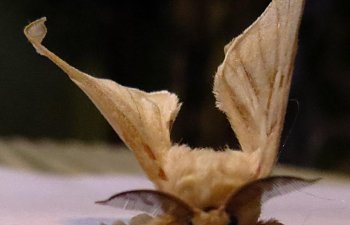
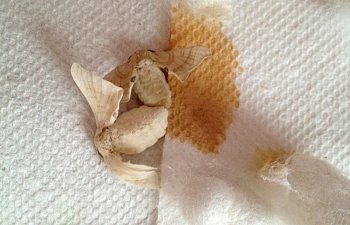
When the eggs are first laid they will be yellow. After several days they will change to tan and then eventually gray. If they do not change color, then they are infertile.
At this point you can leave them at room temp or higher to hatch, or opt to store them for later use. If you would like to store them for later use, you can cut out the egg circles and place them in zip lock bags. I then date the bags and place them in the crisper drawer of the refrigerator until I am ready to hatch them. They will save in the refrigerator for several months.
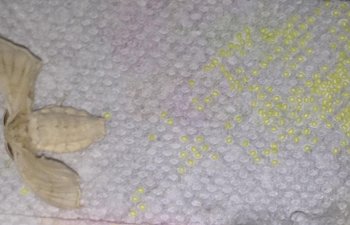
Here is a female with some eggs that were not controlled with toilet paper rolls.
When I am ready to hatch the eggs I place them in to a petri dish.
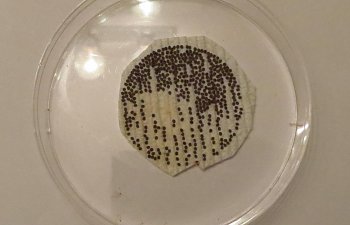
I keep the petri dish on top of some moist paper towels that I mist daily. The eggs need some moisture, but not enough to cause mold or to come in direct contact with the eggs. I also keep them in my bug room which is usually around 80-85 degrees. Unfortunately I cannot give a good estimate on hatching time as mine have been all over the place. Some hatch within a couple weeks and others in greater than 2 months. Update: I now use an incubator set to 85 degrees and my eggs are hatching within a week or so.
When the eggs hatch you will see tiny black worms, at this time you should put small amounts of food in the container with them. The best results seem to be with using a cheese grater and grating a small amount of food over them. You can remove any dried out food if the worms are not on it.
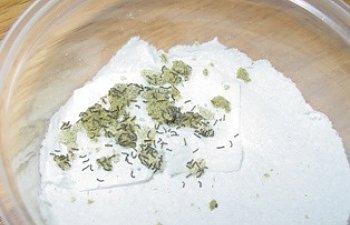
*Photo courtesy of sandrachameleon
As the worms grow they will migrate over to the food which is also a good way to get them where you want them. If you need them to move to another spot so that you can clean the other, just put the food where you want them and they will move. It will take a couple weeks for the worms to grow to a decent size, depending on food availability and room temperature. If you would like to slow their growth down, you can deprive them of food. I have read that they can go up to a week without food, although I have not withdrawn food for more than 2 days at a time.
I do have more pictures of the worms growing up, however I have hit my quota for this blog.
From here you basically just feed them and clean then and once they grow in to their second instar I move them to the tupperware and start over with part 1.
So there you have it….my silk worm rearing and breeding methods. I hope this is helpful to you and if you have any additional questions feel free to let me know. Thanks
